 ?Mathematical formulae have been encoded as MathML and are displayed in this HTML version using MathJax in order to improve their display. Uncheck the box to turn MathJax off. This feature requires Javascript. Click on a formula to zoom.
?Mathematical formulae have been encoded as MathML and are displayed in this HTML version using MathJax in order to improve their display. Uncheck the box to turn MathJax off. This feature requires Javascript. Click on a formula to zoom.Abstract
The housing and management of commercial breeding sows is of crucial importance for their productivity and welfare. The aim of the present study is to evaluate how the scientific community addressed the subject of pregnant sow welfare, how it has changed over the past 30 years and what were the drivers of this change. A search of the literature in Scopus identified 318 articles, which were screened for inclusion criteria. Over one hundred of these publications (n = 102) were deemed relevant for the systematic review. Globally, the number of papers on sow welfare during pregnancy increased, but in the last 5 years the trend changed both in terms of publishing country, the interventions studied and the welfare outcomes employed. Up to 2014, published papers about gestating sow welfare came from Europe and North America, with housing system as the most studied topic, followed by nutrition and feeding, and behaviour as the most common welfare outcome. In the last five years, publications from Europe and North America decreased, while publications from Oceania, America Latina and Asia started to appear. Papers on the management of sows in groups and to a lesser extent, environmental enrichment, increased in number. In addition, while prior to 2009 behaviour was the most common welfare outcome, a more diverse range of welfare outcomes were employed in papers in the last 10 years. In order to support new legislation and to respond to consumer requests, future studies should focus on improving sow comfort during gestation.
The changing geographical pattern of papers on sow welfare reflects the growing concerns internationally for animal welfare.
Future studies should focus on emerging topics, such as the management of sows in groups and environmental enrichment.
It’s important to continue the increasing multidisciplinarity of welfare assessment and to focus on new minimally invasive methods.
Highlights
Keywords:
Introduction
Clearly, optimal sow reproductive performance is crucial to the efficiency and financial profitability of the pig industry. Good welfare during gestation is an important driver of optimal sow performance as stress may impair reproduction by interfering with the endocrine events which in turn induce oestrus, ovulation, and early pregnancy (Turner et al. Citation2005; Einarsson et al. Citation2008; Lagoda et al. Citation2021a, Citation2021b). It is also a crucial aspect from an ethical point of view, considering that gestation is the longest phase in the sow’s productive life, and for a marketing aspect, given consumers’ growing interest towards animal welfare (EC Citation2016).
However, ensuring an adequate state of welfare is a complex issue. Sow welfare may be influenced by many different factors, such as housing systems, group management, feeding plan, but also by animal characteristics (genetics, parity as well as by human–animal interactions) (Verdon et al. Citation2015). Moreover, not only is there no established method to assess animal welfare, but it may differ according to both the different concepts of animal welfare and the purpose of the research (Sejian et al. Citation2011). Indeed, animal welfare is a multidimensional concept involving three main conceptual frameworks, (biological function, affective state and natural living) (Fraser Citation2003). In measuring animal welfare then, methodologies draw on indicators from multiples disciplines that include animal behaviour science, stress physiology, animal science, veterinary science, psychology, immunology and neurophysiology (Hemsworth et al. Citation2015).
In the light of the above-mentioned considerations, it is important that research aims to ensure and improve welfare of gestating sow, in order to support new legislation, to respond to consumers’ request and to be in step with the progress and changes achieved by genetic breeding programs. For example, modern hyper-prolific crossbred sows have become heavier and longer than their ancestors in 1994 (Moustsen et al. Citation2011) and this aspect must be taken into consideration in the design of stalls and pens.
European pig welfare legislation covers all phases of production but several aspects require updating, especially regarding management of the sow. The latest Scientific Opinion of European Food Safety Authority concerning the welfare of sow (EFSA Citation2007) was last updated in 2007. As regards pregnant sows, the report underlines the need for further research on the welfare and health of group-housed sows, especially from weaning to 4 weeks after mating. Indeed, housing sows in individual stalls during this vulnerable period ensures that stressors associated with mixing do not adversely affect embryo implantation and survival (Spoolder et al. Citation2009), but severely restricts their freedom to move and socialise. The report also stresses that in order to make more precise recommendations, there is a need for more knowledge on how sow claw health is affected by different flooring conditions, on bulky content of pregnant sows feed, on access to rooting materials and also on slurry systems that can handle straw or other organic materials. Despite these recommendations, Europe has not made any legislative intervention on sow housing and husbandry since 2001. This is likely to change in coming years in line with the requirements of the European Union’s new Farm to Fork (F2F) strategy where animal welfare has an integral role (EC Citation2020). Indeed, the European Food Safety Authority (EFSA) are currently undertaking a comprehensive evaluation of the EU’s animal welfare legislation (EFSA Citation2020). This is further driven by the successful outcome of the European Citizens’ Initiative (End the Cage Age Citation2018) calling for an end to the use of cages for farmed animals.
Therefore, the first aim of the present study is to evaluate if the scientific community has addressed the subject of pregnant sow welfare and how it has changed since the past 30 years. We will then interpret such changes in the light of associated sociological, legislative, scientific and practical drivers. Informed by these findings, we will conclude with suggestions for an appropriate direction that future research should take on the welfare of gestating sows.
Methods
Protocol
Guidelines for conducting a systematic review were obtained from McMullen et al. (Citation2020). This protocol, reported in accordance with PRISMA-ScR guidelines (Tricco et al. Citation2018), was published at the University of Guelph’s institutional repository (https://atrium.lib.uoguelph.ca/xmlui/handle/10214/17788), and registered online with Systematic Reviews for Animals and Food (SYREAF) available at: http://www.syreaf.org.
Search strategy
The literature search was conducted on 4th of September 2020 in Scopus database, using a string designed to obtain any articles published in the past 30 years that provided data on gestating sow (or gilt) welfare. The search strategy was developed using key concept terms and words, connected using Boolean operators ‘AND’, ‘OR’. In the study, the search string used was:
Study selection
All the articles collected from the online search were exported to Excel (2013) and were scanned to remove those that were included because of keywords that were different to those provided by the author. Indeed, KEY code is a combined field that searches in Author Keywords, but also in Index Terms, Trade Name and Chemical Name. We then manual screened all the publications to remove articles that did not include the chosen search terms in the Title, Abstract or Author Keywords. Thereafter, we removed duplicates from the reference list.
The remaining titles and abstracts were assessed for relevance using the following primary screening questions by two independent reviewers:
‘Is the title and/or abstract available in English?’
‘Does the title and/or abstract assess a gestation intervention in sows and/or gilts?’
‘Does the title and/or abstract describe a relevant welfare outcome?’
‘Does the title and/or abstract describe an analytic primary research study?’
All questions included a response for YES, NO, and UNCLEAR. References were only excluded if both reviewers responded ‘NO’ to any of the questions. Disagreements were resolved by consensus with mediation by a third member of the review team if an agreement could not be reached.
The full-text articles of the citations deemed eligible by the previous stage of screening were assessed using the same four questions and the same eligibility criteria.
Study characteristics
Study characteristics were extracted for all studies included after full-text screening. They included year of publication, country of the first author, journal title, number of citations, study population (sow, gilt or both) and inclusion criteria (interventions and outcomes, see below).
Eligible interventions
The eligible interventions employed in the gestation period were classified as follows:
Housing interventions: included housing system (individual stall, group housing or tether, indoor or outdoor); stall size; floor space allowance; floor characteristics.
Group management interventions: group size; static or dynamic group; group strategy (parity composition, familiarisation, use of tranquilizers); stage of reproductive cycle at mixing.
Nutrition and feeding interventions: feeding system and frequency; level of dietary fibre; feed supplements and additives
Provision of environmental enrichment/foraging material
Eligible outcomes
Outcomes eligible for inclusion in the review were the indicators for the assessment of animal welfare, categorised as:
Behavioural indicators: observation of sow behaviour, including stereotypies, posture, aggressive behaviour, locomotory/activity and others
Physical indicators: body lesions and locomotory problems
Physiological indicators: cortisol level, immune traits, heart rate, antioxidant status
Reproductive indicators: wean-to-oestrus interval, conception rate, farrowing rate, litter size, piglet birth weight and others
Growth/productive indicators: body condition score, body weight, backfat thickness and others
Results and discussion
Study selection
Results of the search and flow of studies through the screening process are presented in Figure . The database search identified 318 articles. After the first scan through the ‘Key’ process, there were 260 articles. Of these publications, seven were removed as duplicates. The remaining 253 articles were screened by title and abstract, and 113 were deemed eligible. Of these publications, 102 were deemed as relevant when the inclusion and exclusion criteria were applied to the full-text.
Figure 1. PRISMA study flow diagram (Moher et al. Citation2009) documenting the process of identification, screening, eligibility and inclusion for the systematic review of welfare of gestating sow.
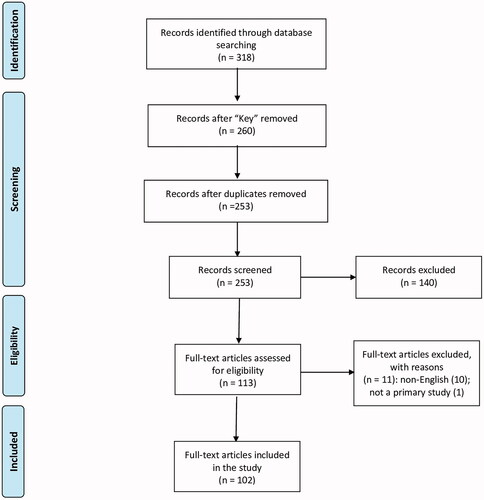
Study characteristics
Studies on the welfare of gestating sows were assigned to 21 countries according to affiliation of the first author, most frequently in Europe (42%) and North America (40%). In Europe, the top four publishing countries are United Kingdom, Belgium, France and Ireland (n = 8; n = 7; n = 7; n = 7, respectively).
Figure shows the distribution of the 102 papers according to the publication year (divided into 6 5-year intervals) and subdivided based on the first author’s country.
Figure 2. Number of papers of welfare of gestating sow distributed according to the publication year in the different continents.
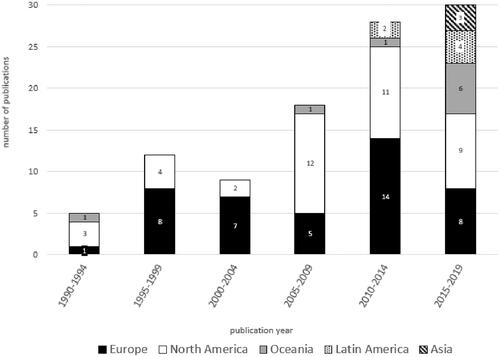
Looking globally, in the last 30 years the number of papers about the welfare of gestating sows increased, except during the period 2000–2004 in which there was a slight reduction. From 1990 to 2014, Europe and North America were substantially the two continents that published papers about the welfare of the gestating sow. In the last five years, Oceania, America Latina and Asia also started publishing articles on this topic and even though they have major pig industries they have minimal or no legislation protecting pig welfare.
China is the world’s largest pork producer (USDA Citation2020), but it has not yet enacted animal welfare legislation, and the reason may be in part due to the lack of animal welfare literature coming from the country (Sinclair et al. Citation2020). In this review, the lack of scientific research is evident: of the three articles from Asia, only one is Chinese. However, a recent review that searched for literature on animal welfare in a Chinese database (Sinclair et al. Citation2020) identified 164 articles on pregnant sow welfare. This could be an opportunity to increase knowledge transfer by making key Chinese animal welfare papers available in English and vice versa, and so establishing closer collaboration with Chinese partners and ultimately improving animal welfare globally. Brazil is the only Latin American country to produce scientific literature on the welfare of gestating sows and it is also the largest pork producer in Latin America. It ranked number 3 in the world pork producers and, since 2014, grew 1.2% year on year (OECD Citation2019). Its growth in production appears to be accompanied by a growth in publishing, but not in law-making. Indeed, there are not any regulations with regards to the rearing of farm animals (API Citation2020a). However, even if sow stalls are not prohibited by legislation, Brazil’s largest pork producers and processors recently announced that they are phasing out gestation crates (Cardoso et al. Citation2017). Australia represents publishing on sow welfare during gestation in Oceania. Australian pork production increased by 2.2% year on year since 2014 (OECD 2019) and this was matched by substantial growth in publishing in the last five years. Nevertheless, there are no national laws relating to farm animal welfare. Commonwealth Government developed a series of National Model Codes of Practice for the Welfare of Livestock, but it serves as a voluntary guide and is not legally binding (API Citation2020b).
Europe and North America addressed the topic of dry sow welfare at different times. Europe began to publish a greater number of papers from the second half of the 1990s, probably influenced by the enactment of European directives in those years. However, though 91/630/EC and 2001/88/EC established important improvements for the welfare of pregnant sows, namely the prohibition of stall housing from day 28 of pregnancy, no further directives were produced that would change the way in which gestating sows were managed or housed. However, this deadlock at the legislative level was not accompanied by a deadlock in scientific research. Rather there was a peak in publications in the 2010–2014 interval. This could be due to the prolonged time that directives allowed for the application of the changes introduced. The most important provisions relating to group housing only became mandatory in 2013 and in the preceding years, scientific research sought the best solution for this change. Some European countries approved more ambitious legislation, exceeding the baseline set at EU level: Sweden (1994), United Kingdom (1999), banned sow stalls entirely, since 2013 the Netherlands restricted individual stall to four days after insemination and in 2020 Germany passed a regulation introducing a ban on sow stalls, but it will become mandatory from 2030. However, except for United Kingdom, these countries are not the same top publishing countries, suggesting that the drivers for change probably had another origin.
North America, on the other hand, began publishing a greater number of papers starting from the 2005-2009 interval. It was precisely in those years that some American states enacted individual state provisions to regulate the living conditions of farm animals, including the ban of gestation crates (Centner Citation2010). However, recommendations for the minimal floor space allowance, for requirements of flooring surfaces, or as regards manipulable material do not exist in the United States.
The 102 papers selected were published in 33 Journals with the Journal of Animal Science (n = 26) and Applied Animal Behaviour Science (n = 20) being the most popular. These publications generated 1931 citations. Three articles collected more than 100 citations (Robert et al. Citation1993 with 115 citations; Broom et al. Citation1995 with 102 citations, Barnett et al. Citation1992 with 101 citations). These articles, although old, certainly represent points of reference for the literature on the welfare of the gestating sow. Sows represented the study population in 61 articles, gilts in 20 articles and both were represented in 21 articles.
Interventions
Table shows the distribution of the selected publications according to the interventions studied. Housing was the subject of the majority of the selected publications (63%), followed by nutrition and feeding (34%), group management (24%) and environmental enrichment (8%). In a few papers, more than one topic was considered.
Table 1. Number and percentage of publications of welfare of gestating sow per topic during the 30-year period.
A number of specific characteristics of each intervention were studied. Housing system was the most commonly studied aspect of housing (59%), and in particular, the comparison between individual stalls and groups (87%). This was followed by floor type (27%) and space allowance (23%). The two main aspects related to nutrition and feeding were feeding system and frequency of feed distribution (43%) and the level of dietary fibre (40%). Group size (42%) and whether static or dynamic (42%) comprised most of the group management studies. Eight publications investigated different objects and material available as environmental enrichment, such as straw, wood, rope, rubber sticks and mats, plastic discs and music.
Figure shows the distribution of the selected papers during the 30-year interval according to the research topic. Until 2014, sow housing was the most studied topic, followed by nutrition and feeding, but in the last five years (6th interval) the trend changed such that publications on group management and to a lesser extent, environmental enrichment, increased in number. Looking at these data it might seem that, as regards European legislation, scientific research is supportive not so much for the issuance of regulations, as for their best application. In fact, the European Union introduced the requirement to keep sows in groups and to provide them with manipulable materials since 2001/88/EC. However, scientists only became interested in these research topics at a later stage, starting from the 2010–2014 interval (Figure ), when the provisions became mandatory to all holdings. This could be due to the fact that EU legislation gives only a few instructions and obligations on how apply it. As regards group management, legislation made precise provisions only regarding the period in which sows are in groups. Scientific research may have focussed on other management aspects, like group size and type (static or dynamic), in order to give indications on how best to implement the provisions. Also, as regards environmental enrichments, EU legislation provides some examples of manipulable material but it does not give precision indications on quantity, on how it must be provided nor does it distinguish between the different ethological needs for the different categories of pigs. This lack of information, combined with the need to find environmental enrichment suited to both the needs of pregnant sows and of farmers, could be what has prompted more research in this area in the last 10 years.
Figure 3. Number of papers of welfare of gestating sow distributed according to the publication year and classified according to the four topics considered.
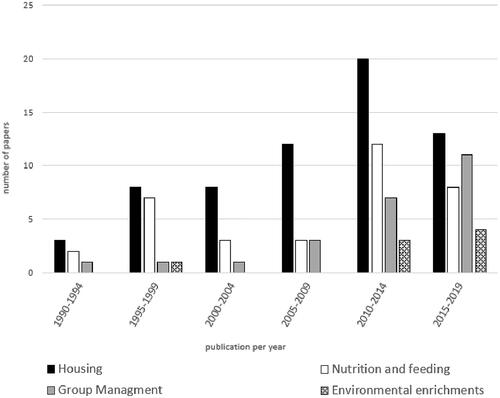
Figure 4. Number of group management (a) and environmental enrichments (b) papers distributed according to the publication year in the different continents.
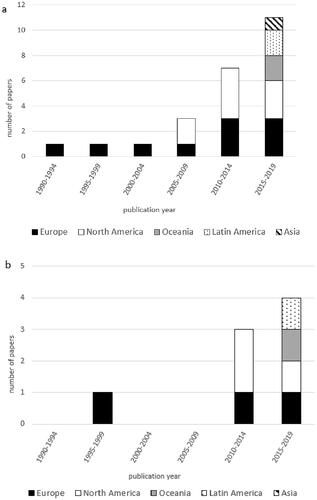
Publications from North America concerning group management started to emerge from 2005 to 2009 (Figure ). This period coincided with the ban on gestation stalls in some US states, and therefore this seems consistent with the increase in scientific interest in managing sows in groups. However, most USA States do not place any limits on the use of individual stalls and private food companies seem to be the main driver. Since 2007, over 40 companies and several grocery store giants, including Smithfield Foods, United States’ largest pig producer, McDonalds, Cargill, Hormel Foods, and the two largest foodservice companies in the world, announced plans to phase out the use of gestation crates (HSUS Citation2013). As regards the companies mentioned above, all seem (except for the Compass group, which does not disclose this information) to have actually undertaken to reduce or eliminate the use of gestation crates, albeit with different results. For example, Smithfield Foods fulfilled its commitment to provide group-housing systems for pregnant sows on all company-owned farms in the United States. McDonald's, rather, in the latest statement reports that 50% of the U.S. pork supply chain has phased out the use of gestation stalls for pregnant sows. Regarding instead Sodexo, the second largest foodservice company in the world, in the end of 2020, it states that only 24% of their pork came from traceable reduced gestation stalls supply chains, and a small amount from completely crate-free operations.
As regards environmental enrichment, North American researchers began to publish papers starting from the 2010 to 2014 interval, but this appears to be due to public concerns about farm animals and market forces and not to legislative pressure. Indeed, US swine farmers are not required by federal law to provide rooting materials, but they may provide these materials for market driven reasons if they voluntarily adhere to certain animal welfare certification programs (Horback et al. Citation2016).
Looking globally, it is also clear that the increase in publications on these two topics in the last 5 years is mainly due to the addition of papers from the other continents which were absent previously. In the last five years, both Brazil and Australia published two papers about group management and one paper about environmental enrichment. This recent scientific interest gives hope for a new sow welfare reform. This appears to be imminent in Australia compared to Latin America. Indeed, a recent nationally representative survey (Futureye Pty Ltd. Department of Agriculture and Water Resources Citation2018) shows that the vast majority (95%) of respondents consider farm animal welfare in Australia to be an issue to some degree and 91% require at least some reform to address it. This indicates that the Australian Government are out of step with public expectations, and it is being strongly encouraged to ban the extreme confinement of farm animals (API Citation2020b). In contrast, little is known about the view of citizens from developing countries (von Keyserlingk and Hötzel Citation2015). Brazilian citizens have a low level of awareness regarding livestock production system (Yunes et al. Citation2017). However, different studies show that increasing information tends to result in increased opposition to intensive livestock production practice and system (Bonamigo et al. Citation2012; Souza et al. Citation2013). It appears that citizens prefer systems that are not associated with behavioural restrictions (Yunes et al. Citation2017; Hötzel et al. Citation2017). Despite the different pressures from public opinions, several important Brazilian (Aurora, Brazil Foods and JBS S.A.) and Australian (Australian Pork) industries committed to voluntary phasing out sow stalls. In the absence of a national law banning gestation stalls, these corporate polices appear very important to meet consumers expectations or to avoid the risk that certain housing and management practices may undermine the socially sustainability of the current farming system once the public becomes aware of them.
As regards Asia’s papers about these two topics, only Israel published one paper on sow group management in 2018. Although pig production in Israel is limited to nearly 38.000 sows (FAO Citation2019), since 2014, according to the Israeli Swine Legislation, the use of individual confinement stalls during gestation is not allowed. The lack of scientific research from Asia is evident, not only for these two topics but for the overall welfare of gestating sows. As mentioned above, the paucity of Chinese publications is probably due to the unavailability to the English-speaking global scientific community (Sinclair et al. Citation2020). Little is known about the other Asian countries, some of which, such as Vietnam and South Korea have large pig industries.
Housing, nutrition and feeding papers decreased sharply in the last five years (Figure ). Concerning housing interventions (Figure ), it is mainly due to the limited number of articles comparing individual stalls and group housing (Figure ). From 2015 to 2019, there were no European publications on this topic, and only limited publications from North America. Floor space allowance papers followed the same trend, but in recent years, publications from Australia contributed to an increase (Figure ). Additionally, the number of papers on floor quality reduced sharply in the last five years, due to fewer European publications (Figure ). The decrease seen in publications relating to nutrition and feeding (Figure ) is mainly due to the limited number of articles comparing different feeding systems and frequency (Figure ) (main topic for nutrition and feeding until then). In the last five years, only one paper was published on this topic from the United States, while the number of papers on fibre remained roughly unchanged (Figure ). On the other hand, we found two articles on ‘feed supplement and additive’, topic cited in one article only, until 2014.
Figure 5. Number of papers of the three main housing interventions (individual stalls vs. group housing (a); space allowance (b); floor characteristics (c)) distributed according to the publication year in the different continents.
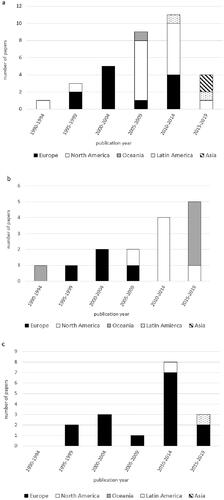
Figure 6. Number of papers of the two main Nutrition and Feeding interventions (feeding system and frequency (a); level of dietary fibre (b)) distributed according to the publication year in the different continent.
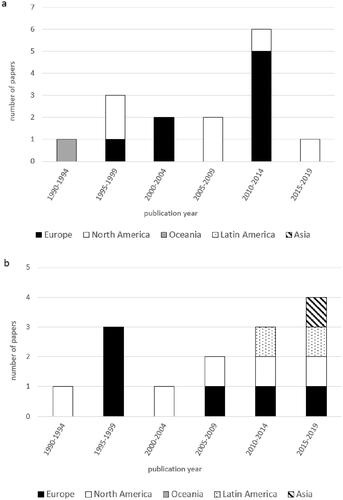
From these data, it seems that research interest in topics that are already tightly regulated by the EU is decreasing. This includes the use of individual stalls/cages, floor space allowance and quality as well as sow feeding systems. All of these topics are very important to the welfare of the gestating sow, especially when housed in groups (Verdon et al. Citation2015) and deserve research attention to better refine group-housing systems for gestating sows. Moreover, taking into account the successful recent European Citizens’ Initiative End the Cage Age which calls on European Union to end cage confinement of farm animals, it is very important that the European scientific community takes account of the new consumers requirements, and therefore implements research on topics already regulated by legislation, but which may need to be modified. The European Commission in response to the initiative ‘intends to propose to phase out and finally prohibit the use of such cage systems. This will be included as one of the key objectives of the revision of animal welfare legislation that the Commission has committed to propose by the last quarter of 2023.’ This is a displayed quotation (EC C(2021) 4747 Citation2021, p. 9).
The decreasing number of publications in the last five years in these topics, like the use of individual stalls, floor allowance and quality is also evident in North America, even if in the vast majority of the American countries there is still no regulation of these practices.
Outcomes of the selected studies
Of the 120 publications included in the study, behaviour was the most commonly reported welfare outcome (74%), followed by physical indicators (57%). All the other outcomes (reproductive performance 50%, productive performance 48% and physiological indicators 47%) were similar (Table ). In Table , the specific aspects of each welfare outcome are also detailed. As regards behavioural observation, the main aspects of sow ethogram were utilised equally, and the different approaches developed during this 30-year period are not evident from this review. Only a few studies introduced motivation and positive social contact in their behavioural research and none used a relatively new scientific method to evaluate the expression quality of animal behaviour and emotions: Qualitative Behaviour Assessment. This behaviour assessment is included in the Welfare Quality® (Citation2009) to identify sow emotional state, but the scientific community did not embrace this measure in studies of gestating sow welfare. This can be correlated with the recent growing interest in the other indicators. Indeed, if up until 2009 behaviour was the most common welfare outcome, in the last 10 years each of the other welfare outcomes were employed at similar frequencies, and in the last five years reproductive performance and physical indicators were utilised more often than all other welfare assessment (Figure ). This reflects the increasing multidisciplinarity and importance of welfare assessment (Sejian et al. Citation2011) but it is also probably due to the increased number of group management papers. This is in fact the only intervention in which sow welfare was most frequently evaluated through physical indicators and reproductive performance (Figure ). Group management papers turn out to have these different percentages probably because aggression is the most obvious welfare implication in group housing (Bench et al. Citation2013), and its consequences on injuries (e.g. Turner et al. Citation2006; Schneider et al. Citation2007) and reproductive performance (Salak-Johnson Citation2017) are some of the most important indicators for both sow welfare and herd productivity.
Figure 7. Percentage of papers of welfare of gestating sow distributed according to the publication year and classified according to the welfare outcomes considered.
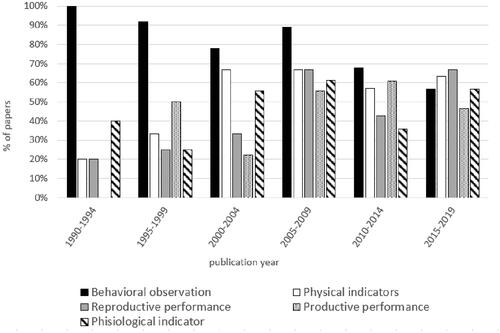
Figure 8. Percentage of papers of welfare of gestating sow classified according to the welfare outcomes considered for each of the four main topics (housing, nutrition and feeding, group management and environmental enrichment).
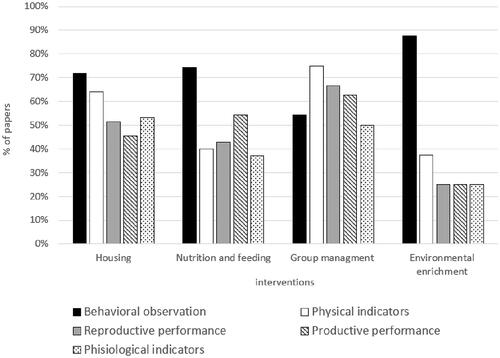
Table 2. Number and percentage of publications of welfare of gestating sow per welfare outcomes during the 30-year period.
As regards physical indicators, body lesions were the most frequently evaluated indicator (88%) followed by locomotory problems (57%), while reproductive performance was evaluated through litter size for all publications, 63% used birth weight, 20% farrowing rate, 14% conception rate and 12% gestation length (Table ).
Concerning the other two welfare outcomes, body weight and backfat thickness were the most employed indicators of productive performance (78% and 71%, respectively), while cortisol (79%; salivary 44% and serum 33%) was by far the most frequently employed physiological indicator followed by measures of immune function (40%). Although there is no dispute over the assumption that stressful experiences cause the synthesis and release of cortisol from the adrenal gland (Seyle Citation1935), its use in assessing animal welfare has limitations related to the fact that its levels can be affected by many other factors (Lane Citation2006). Furthermore, the process of sampling can in itself be a stressful event, interfering with the stress marker. In particular, this could occur with invasive sampling methods, such as blood samples (Sheriff et al. Citation2011), and therefore, there is a growing interest in less invasive sampling techniques. Our findings indicate that despite this evidence, serum cortisol is still often used and the only non-invasive assessment of cortisol used is saliva sampling. This technique is quite practicable in sow herds and minimally invasive, but its level may rise if sampling is contaminated with food (Heimbürge et al. Citation2019). Only one paper used an alternative measurement, urinary cortisol, and none of them considered others alternatives like hair cortisol. This measurement is minimally invasive and has proven to be a useful biomarker of long-term stress in sows and growing pigs (Bacci et al. Citation2014; Casal et al. Citation2017a, Citation2017b; Lagodaet al. Citation2021b).
Conclusion
Clearly, it appears that scientific research on the welfare of gestating sows is increasing globally but some topics, such as provide high fibre diets and environmental enrichment, need more attention. Importantly, further studies on the effects of management of sows in groups are required as the industry moves away from stall housing internationally. Research is particularly needed on the time of introducing sows to groups which is pertinent giving the current review of EU legislation which permits housing sows in gestation stalls for the first 28 days post-service.
In order to ensure the sustainability of pig production, it is clear that research needs to be in step with societally driven legislative and industry changes in pig production. This requires proactive research policies underpinned by targeted funding, international research groups that can find the best solutions to be adapted in different farming systems and structures, better communication between legislation, the scientific world, farmers and consumers and finally, better sharing of research in non-English publications. Until recently, the limitations that research may have encountered could lie in the difficulty of undertaking research projects, both due to the challenges in finding farms capable of hosting a research project, and due to the lack of funded projects.
Countries further behind in legislation and research on the welfare of pregnant sows could interface with the most advanced countries, thus catching up more easily and quickly. Even the most advanced countries, such as those in Europe, should continue research in this area in order to give greater support to further legislative changes required to meet societal demands, as stated in the Farm to Fork strategy (European Commission 2020). The increasing demands for more welfare-friendly farming methods and the importance that citizen has in directing legislation (End the Cage Age Initiative) and consequentially in research, has given (European Commission 2021), and most likely will give, the tools to change the legislation. In this scenario, the aim of scientific world should be to make easier to align legislation with social expectations and to make it easier to enforce these changes.
Ethical Approval
The present paper is a review ad not an experimental study, therefore it does not contain any studies with human or animal subjects.
Acknowledgements
Maria Costanza Galli was supported by a doctoral fellowship from the Fondazione Cariparo at University of Padova (Italy).
Disclosure statement
No potential conflict of interest was reported by the authors.
Data availability statement
The data that support the findings of this study are available from the corresponding author, FG, upon reasonable request.
References
- [API] Animal Protection Index 2020a. Federative Republic of Brazil. [accessed 2021 April 1]. https://api.worldanimalprotection.org/country/brazil.
- [API] Animal Protection Index 2020b. Commonwealth of Australia. [accessed 2021 April 1]. https://api.worldanimalprotection.org/country/australia.
- Bacci ML, Nannoni E, Govoni N, Scorrano F, Zannoni A, Forni M, Martelli G, Sardi L. 2014. Hair cortisol determination in sows in two consecutive reproductive cycles. Reprod Biol. 14(3):218–223.
- Barnett JL, Hemsworth PH, Cronin GM, Newman EA, McCallum TH, Chilton D. 1992. Effect of pen size, partial stalls, and method of feeding on welfare-related behavioral and physiological responses of group-housed pigs. Appl Anim Behav Sci. 34(3):207–220.
- Bench CJ, Rioja-Lang FC, Hayne SM, Gonyou HW. 2013. Group gestation sow housing with individual feeding-II: how space allowance, group size and composition, and flooring affect sow welfare. Livest Sci. 152(2-3):218–227.
- Bonamigo A, Bonamigo CBSS, Molento CFM. 2012. Broiler meat characteristics relevant to the consumer: focus on animal welfare. Braz J Anim Sci. 41:1044–1050.
- Broom DM, Mendl MT, Zanella AJ. 1995. A comparison of the welfare of sows in different housing conditions. Anim Sci. 61(2):369–385.
- Cardoso CS, Von Keyserlingk MAG, Hötzel MJ. 2017. Brazilian citizens: expectations regarding dairy cattle welfare and awareness of contentious practices. Animals. 7(12):89.
- Casal N, Manteca X, Peña LR, Bassols A, Fàbrega E. 2017a. Analysis of cortisol in hair samples as an indicator of stress in pigs. J Vet Behav Clin Appl Res. 19:1–6.
- Casal N, Manteca X, Escribano D, Cerón JJ, Fàbrega E. 2017b. Effect of environmental enrichment and herbal compound supplementation on physiological stress indicators (chromogranin A, cortisol and tumour necrosis factor-α) in growing pigs. Animal. 11(7):1228–1236.
- Centner TJ. 2010. Limitations on the confinement of food animals in the United States. J Agric Environ Ethics. 23(5):469–486.
- [EFSA] European Food Safety Authority. 2007. Scientific Opinion of the Panel on Animal Health and Welfare on a request from the Commission on Animal health and welfare aspects of different housing and husbandry systems for adult breeding boars, pregnant, farrowing sows and unweaned piglets. Efsa J. 572:1–13.
- [EFSA] 2020. European Food Safety Authority. [accessed 2021 Sept 15]. https://www.efsa.europa.eu/en/topics/topic/animal-welfare#farm-to-fork-review.
- Einarsson S, Brandt Y, Lundeheim N, Madej A. 2008. Stress and its influence on reproduction in pigs: a review. Acta Vet Scand. 50:48.
- End the Cage Age 2018. [accessed 2021 September 15]. https://www.endthecageage.eu/.
- [EC] European Commission. 2016. Special Eurobarometer 442 Report: Attitudes of Europeans towards Animal Welfare.
- [EC] European Commission. 2020. Farm to Fork Strategy: For a fair, healthy and environmentally-friendly food system. [accessed 2021 April 1]. https://ec.europa.eu/food/sites/food/files/safety/docs/f2f_action-plan_2020_strategy-info_en.pdf.
- [EC] European Commission. 2021. Communication from the Commission on the European Citizens' Initiative (ECI) "End the Cage Age". C(2021) 4747 final.
- [FAO] 2019. Agriculture Organization. Numbers of pigs. [accessed 2021 August 24]. https://www.nationmaster.com/nmx/timeseries/israel-number-of-pigs-fao.
- Fraser D. 2003. Assessing animal welfare at the farm and group level: the interplay of science and values. Anim Welf. 12:433–443.
- Futureye Pty Ltd. Department of Agriculture and Water Resources. 2018. Commodity or sentient being? Australia’s shifting mindset on farm animal welfare. [accessed 2021 April 1]. https://futureye.com/resources/.
- Hemsworth PH, Mellor DJ, Cronin GM, Tilbrook AJ. 2015. Scientific assessment of animal welfare. N Z Vet J. 63(1):24–30.
- Heimbürge S, Kanitz E, Otten W. 2019. The use of hair cortisol for the assessment of stress in animals. Gen Comp Endocrinol. 270:10–17.
- Hötzel MJ, Roslindo A, Cardoso CS, von Keyserlingk MAG. 2017. Citizens' views on the practices of zero-grazing and cow-calf separation in the dairy industry: Does providing information increase acceptability? J Dairy Sci. 100(5):4150–4160.
- Horback KM, Pierdon MK, Parsons TD. 2016. Behavioral preference for different enrichment objects in a commercial sow herd. Appl Anim Behav Sci. 184:7–15.
- [HSUS] The Humane Society of the United States. 2013. An HSUS Report: welfare issues with gestation crates for pregnant sows. [accessed 2021 April 1]. https://www.humanesociety.org/sites/default/files/docs/hsus-report-gestation-crates-for-pregnant-sows.pdf.
- Lagoda ME, Boyle LA, Marchewka J, Calderón Díaz JA. 2021a. Mixing aggression intensity is associated with age at first service and floor type during gestation, with implications for sow reproductive performance. Animal. 15(3):100158.
- Lagoda ME, O'Driscoll K, Marchewka J, Foister S, Turner SP, Boyle LA. 2021b. Associations between skin lesion counts, hair cortisol concentrations and reproductive performance in group housed sows. Livest Sci. 246:104463.
- Lane J. 2006. Can non‐invasive glucocorticoid measures be used as reliable indicators of stress in animals? Anim Welf. 15:331–342.
- McMullen CK, Sargeant JM, Kelton DF, Winder CB. 2020. Modifiable management practices to improve udder health in dairy cattle at dry-off: a protocol for a scoping review. [accessed 2021 April 1]. https://atrium.lib.uoguelph.ca/xmlui/handle/10214/17788,http://www.syreaf.org.
- Moher D, Liberati A, Tetzlaff J, Altman DG, The PRISMA Group. 2009. Preferred reporting items for systematic reviews and meta-analyses: the PRISMA statement. PLoS Med. 6(7):e1000097.
- Moustsen VA, Lahrmann HP, D'Eath RB. 2011. Relationship between size and age of modern hyper-prolific crossbred sows. Livest Sci. 141(2-3):272–275.
- [OECD] Organization for Economic Co-operation and Development. 2019. Pork Production. [accessed 2021 April 1]. https://www.nationmaster.com/nmx/ranking/pork-production.
- Robert S, Matte JJ, Farmer C, Girard CL, Martineau GP. 1993. High-fibre diets for sows: effects on stereotypies and adjunctive drinking. Appl Anim Behav Sci. 37(4):297–309.
- Salak-Johnson JL. 2017. Social status and housing factors affect reproductive performance of pregnant sows in groups. Mol Reprod Dev. 84(9):905–909.
- Schneider JD, Tokach MD, Dritz SS, Nelssen JL, DeRouchey JM, Goodband RD. 2007. Effects of feeding schedule on body condition, aggressiveness, and reproductive failure in group-housed sows. J Anim Sci. 85(12):3462–3469.
- Sejian V, Lakritz J, Ezeji T, Lal R. 2011. Assessment methods and indicators of animal welfare. Asian J Anim Veter Adv. 6(4):301–315.
- Seyle H. 1935. A syndrome produced by diverse nocuous agents. Nature. 138:32–33.
- Sheriff MJ, Dantzer B, Delehanty B, Palme R, Boonstra R. 2011. Measuring stress in wildlife: techniques for quantifying glucocorticoids. Oecologia. 166(4):869–887.
- Sinclair M, Zhang Y, Descovich K, Phillips CJC. 2020. Farm animal welfare science in China-a bibliometric review of Chinese literature. Animals (Basel). 10(3):540.
- Souza MCGL, Casotti LM, Lemme CF. 2013. Conscious consumption as a driver for corporate sustainability: can good business arise from respecting the animals? Rev Adm. 6:229–246.
- Spoolder HAM, Geudeke MJ, Van Der Peet-Schwering CMC, Soede NM. 2009. Group housing of sows in early pregnancy: a review of success and risk factors. Livest. Sci. 125(1):1–14.
- Tricco AC, Lillie E, Zarin W, O'Brien KK, Colquhoun H, Levac D, Moher D, Peters MDJ, Horsley T, Weeks L, et al. 2018. PRISMA extension for scoping reviews (PRISMA-ScR): checklist and explanation. Ann Intern Med. 169(7):467–473.
- Turner AI, Hemsworth PH, Tilbrook AJ. 2005. Susceptibility of reproduction in female pigs to impairment by stress or elevation of cortisol. Domest Anim Endocrinol. 29(2):398–410.
- Turner SP, Farnworth MJ, White IMS, Brotherstone S, Mendl M, Knap P, Penny P, Lawrence AB. 2006. The accumulation of skin lesions and their use as a predictor of individual aggressiveness in pigs. Appl Anim Behav Sci. 96(3-4):245–259.
- [USDA] United States Department of Agriculture, Foreign Agricultural Service 2020. Livestock and poultry: world markets and trade. [accessed 2021 April 1]. https://www.fas.usda.gov/data/livestock-and-poultry-world-markets-and-trade.
- Verdon M, Hansen CF, Rault JL, Jongman E, Hansen LU, Plush K, Hemsworth PH. 2015. Effects of group housing on sow welfare: a review. J Anim Sci. 93(5):1999–2017.
- von Keyserlingk MAG, Hötzel MJ. 2015. The ticking clock: addressing farm animal welfare in emerging countries. J Agric Environ Ethics. 28(1):179–195.
- Welfare Quality®. 2009. Welfare Quality ® assessment protocol for pigs (sows and piglets, growing and finishing pigs). Welfare Quality ® Consortium, Lelystad, The Netherlands.
- Yunes MC, Von Keyserlingk MAG, Hötzel MJ. 2017. Brazilian citizens’ opinions and attitudes about farm animal production systems. Animals. 7(12):75.
